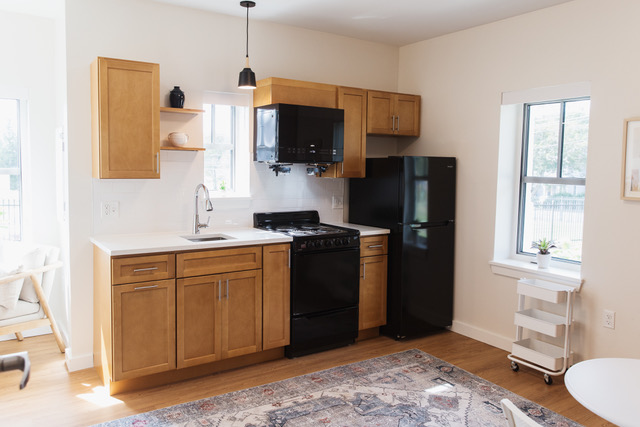By Connie Kruger

You may have spotted the new three-story building on Route 9 next to Amherst College’s Pratt Field. East Gables provides affordable housing and on-site services for people who have been homeless or are at risk of homelessness. It opened in October and is now fully occupied, with 28 residents. Although this type of building has been a missing part of Amherst’s housing supply, community resistance threatened to block its development.
There was similar opposition to such housing across the state. This article explores some of the points of opposition to East Gables and some factors that led to its successful completion.
About East Gables
Initially, the Town of Amherst had requested and funded the efforts of the Valley Community Development (“Valley”) to find a site for this type of housing. Securing the land adjacent to the Amherst College playing fields culminated a two-year search.
The building provides 28 studio-style apartments, each with its own bathroom and kitchen, as well as community gathering and office spaces. East Gables is designed to rigorous Passive House standards and uses no fossil fuels to power the building.



The Town provided $1 million in local funds and the remaining, approximately $8 million, came from the state and other funding sources. In November, Governor Maura Healey and Secretary of Housing and Livable Communities Ed Augustus toured the building, which was praised as a model for this type of housing.
By the close of a lottery period last June, 501 applications had been received, proving the need for this kind of housing. Seventy percent of the housing was set aside for people who lived or worked in Amherst. Half the residents are working and half are women.
“We are struck by the number of tenants who were homeless and working full-time jobs, many of them in Amherst and Hadley,” said Laura Baker, Valley’s real estate development director. “Even with full-time employment, they were not able to afford local rents.”



Amherst’s Neighborhood Defenders
Despite the documented need for this type of housing in Amherst, the path to approval and permitting for East Gables was not a smooth one. Neighbors had many concerns about who would be living there, how the building would be managed, and the impact on the nearby area. It took many meetings with neighbors, interested individuals, and town boards to provide enough information to overcome their initial fears.
The book Neighborhood Defenders, by Boston University professors Katherine Einstein, David Glick, and Maxwell Palmer, helped me understand this opposition. The authors reviewed 100 cases of randomly selected minutes from permit hearings in 97 communities in the greater Boston area.
“Neighborhood Defenders is fundamentally about the people who participate in local housing politics and institutions in which they participate,” they wrote. “It centers on the motivated residents who show up at meetings to oppose new housing and zoning changes…Projects are not necessarily stopped by zoning codes alone. They are often delayed, stopped, or altered by interested residents using local land use institutions.”
I find the term NIMBY (Not In My Backyard) problematic in describing people with objections or critiques of an affordable housing development. It’s a negative term that leaves people feeling defensive, and it increases division around an already contentious situation. I prefer “neighborhood defender” because I think it captures the urge to protect one’s family, neighborhood and community from a perceived threat.
“Concerns framed narrowly around selfish economic interest seem unlikely to motivate large neighborhood movements or sway zoning and planning board members,” the authors wrote. ”In contrast, a community orientation based around defending one’s neighborhood seems both unifying to a broader swath of the population and more appealing to the political elites. No one wants to be known as a politician who caves in to NIMBYs — or, indeed, as NIMBY themselves. …People who oppose housing largely do not think they are being selfish; they believe they are community-minded neighborhood defenders.”
Some of the insights in this book can help inform future local efforts.
Who Participates in Local Land Use Decisions
I firmly believe that residents should participate in the public process and be well informed about what is proposed near them, and that they often offer valuable perspectives. Public participation in the permitting process correlates with Amherst’s values. But who is (and is not) participating in land-use decisions has a big impact on what gets done.
The book describes neighborhood defenders as more socio-economically advantaged than the larger community population. They tend to be white, older, and homeowners. In Amherst, this was true of opponents of East Gables.
In a letter to the Town Council endorsed by 56 people, neighbors claimed expert knowledge. Opponents submitted extensive information on topics such as the projected rates of recidivism for drug addicts, and a projected rate of police calls based on extrapolation of Northampton police logs for developments they selected as comparable.
“We are medical doctors, psychiatrists, small business owners, neuroscientists, psychologists, and… several of us are scientists who value the rigorous use of data,” they wrote. “Members of our group provided data and expert testimony designed to inform policy decisions, outlining why Valley CDC’s plan for this project is inadequate. Simply put, the data suggest that this very vulnerable population needs more help than is included in Valley CDC’s plan.”
Objections and Tactics of Opponents
According to Neighborhood Defenders, there are typical objections to new housing developments. For East Gables, most of the concerns matched this list of common concerns: traffic, pedestrians, density, aesthetics, safety, parking, and neighborhood character. The East Gables objections also included the perceived need for more on-site staff because neighbors felt that tenants would be under-supervised. (As a result of the public participation process, the number of staff hours were increased, as was the number of parking spaces.)
Some of the letters to the Town Council and later to the Zoning Board of Appeals, while outliers, illustrated a genuine fear factor. One said she needed to get a gun to protect her grandchildren. Another said they would put themselves in front of the bulldozers, and one talked about Pratt Field becoming a site for disposed hypodermic needles.
Safety was a big concern. Neighborhood “experts” predicted 68 police calls a year to East Gables. (Amherst Police dispatch records show zero calls so far.) Some of the fears expressed are understandable in the context of some national media coverage of similar populations. Opponents did not trust assurances about tenant screening and management.
Another effective tactic used by neighborhood defenders is the power of delay, which sometimes leads to the withdrawal of an application or significantly adds to the cost. Asking for additional data or studies is often part of this effort. In addition to the 10 ZBA meetings between June and October 2020, Valley estimates that it attended 12 to 15 meetings with residents, Amherst College, Town Councilors, and others. Councilors, town staff, and Valley responded to dozens of requests for additional information. The time needed to address added requests can strain the already-thin budget of an affordable housing development.
The Power of Supporters
What makes East Gables different from the projects in Neighborhood Defenders is the number of supporters who turned out.

The authors found that typically only 15 percent of participants in the process are in favor of proposed housing. With the East Gables development, well over half, if not more, of the comments received over the course of the ZBA hearing process were from supporters.
John Hornik, then chair of the Amherst Municipal Housing Trust, was active and successful in organizing community support.
One turning point came from students at Amherst College. They sent letters of support to the Town, and a number of articles appeared in the college newspaper. One student called out 15 Amherst College faculty and administrative staff by name.
“For students from low-income backgrounds, being taught by professors whom they know might not want them as their neighbor creates a rift that ultimately impacts students’ relationships with their professors,” an editorial stated. “If professors show up for work expected to make decisions with inclusion in mind but go home and advocate to keep their neighborhood homogeneous, then undeniable tension arises….at the end of the day, these 15 votes of resistance pose real obstacles to getting people off the streets and helping them exit the vicious cycle of systemic poverty.”
Ultimately, the show of support from Amherst’s residents, community organizations, Amherst College, and the steady and patient support of elected and appointed Town officials, got this housing completed. The development permit was granted, for the most part, as originally proposed, and included the request for local preference in choosing tenants, increased staff hours and additional parking. The professionalism and diligence of dedicated Valley staff in managing a lengthy, demanding and often frustrating development process was essential.
A clear message from the East Gables experience is how critical it is to show up, in person or in writing, to support housing for those who need it the most. The path may not always be easy, but with good planning and respect for our different perspectives, positive outcomes are possible.
Amherst has bent the arc of justice toward providing housing for people who need it.
Connie Kruger is a former Amherst Senior Planner, Select Board member, a Massachusetts Housing Partnership Project Manager and served on the Massachusetts Housing Appeals Committee.

Great success story all around. I would be happy to welcome such a development in my neighborhood. This building follows the research recommended housing first model, provides great services to the community members who live there, and is aesthetically a welcome improvement to the area. Hopefully those in opposition to the project will come around to welcome their new neighbors and be open to economically diversifying that area of town.
LikeLike
Thanks, Connie, for this thoughtful and informative piece.
LikeLike
I’m glad that 28 people now have a safe, cheap place to call home.
I got out my calculator. At a cost of $9,000,000.00 to house the 28 lottery winners, that comes to over $321,000 per person, not including ongoing staffing, maintenance and utility costs. There were 501 applications received. So to solve the housing problems of just the 501 who applied, (there are surely many more) it would cost $161 million for construction. The Town’s entire budget is around $93 million. Clearly public housing projects like East Gables alone can’t solve the housing crisis.
We need to look at the State and local regulations that are preventing the private sector from creating homes. Why is it illegal for more than 4 people to live in a six bedroom house? Why do we need granite curbs, and hundreds of feet of road frontage for a building lot? Why does it take years and years to get the necessary permits to build even a modest apartment building? When people are sleeping in cardboard boxes and flimsy tents, why do we require $20,000 sprinkler systems in each new apartment? Why does UMass accept far more students than it has housing for?
Don’t get me wrong – I love that my house is going up in value each year. But I’d love it even more if we got serious about getting housing for my fellow human beings.
Simon Peter Alciere
LikeLiked by 1 person